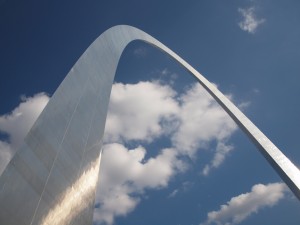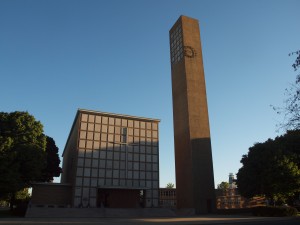
Kleinhan’s Music Hall, a National Historic Landmark in Buffalo, was designed by Eliel and Eero Saarinen in 1940, in their own version of the International Style.
Good Design
The birthday last week of two of my favorite architects, who also happen to be father and son, has gotten me thinking about good design. Eliel Saarinen was born in 1873. His son Eero was born in 1910. Both were born on August 20th. I can’t think of anything either one designed that is not superb. From Cranbrook to the Gateway Arch to the Tulip chair, these Finnish born architects continually reinvented their design approach and continually gave the world places and things of great beauty. When people comment that I am a “preservationist” I usually correct them and say I am an architect first, preservationist second. But what I really am is a lover of great design – regardless of whether it’s old or new. And architects like the Saarinens are exemplars of that – all of their work is so beautiful that it stops you in your tracks – what I call the “I’m not worthy, I’m not worthy” factor. (So included in this post are some photos of Saarinen buildings I’ve visited.)
Are all preservationists activists?
Now I just said that I don’t usually call myself a “preservationist”. Maybe it’s because the implications of that word typically gives me pause. I’ve never demonstrated to save a building or stop a demolition. I am a preservation professional – an architect, historian and planner. I am trained and experienced in the technical, philosophical and regulatory aspects of “preservation.” I can tell you how to save a building. I can save a building. But I’ve often said that the only building I would ever chain myself to is the Richardson Olmsted Complex – and that is for so many reasons – personal, professional, cultural and emotional. But fortunately I haven’t needed to. I stuck around for 30 years like so many others did, trying so many ways to “save” it and now it’s in the midst of a glorious rehabilitation. Sometimes it takes 30 years. Patience is sometimes the best preservation tool.
I admire activists. I admire their patience and sense of urgency. Just a few days ago I heard that a building that was in imminent danger of demolition at the old Bethlehem Steel Plant – literally the “wrecking ball” was at its doors – received a 90-day stay of demolition. A group calling themselves the “Young Preservationists” literally camped out to bring awareness to the building’s plight. And further west in New York State the online effort of a group to save the only remaining place to tell the story of Nikola Tesla, Wardenclyffe, has received an astonishing influx of funds to at least take on ownership.

My visit to the Gateway Arch in St. Louis, designed by Eliel Saarinen in 1947 and opened to the public in 1967, was one of the most breathtaking experiences of my life. Icons are typically easier to save than the nice background buildings. But they are all important in telling the many-layered story of America.
So you may detect some hesitancy in my voice about these preservation wins. And here’s why. While I am typically a glass half full kind of gal, because I have worked in the preservation field now for over 25 years, I know that just saving the building from the wrecking ball doesn’t mean it will be saved and reused for the future. Of course, if it’s not saved from demolition, there is no chance. But I look at the Bethlehem Steel administration building and think, it’s saved, now what? Another museum? And the Tesla Building (and I am a huge geek fan of Tesla), the same thing. It’s saved, now what? Another museum? It takes the diligence, passion, wherewithal and funding to take a place from the wrecking ball or demolition by neglect to a functioning, usable building. Which sometimes IS a museum and sometimes is something else. Will every site have the constituency and patience for 30 years that it sometimes takes? Probably not.
The Dignity of a Good Death
Do I want these buildings to end up in the landfill? Of course I don’t! Neither is a spectacular or iconic work of architecture. But equally important, they tell another piece of the many-layered story that is America. From a materials resource standpoint they are more important to us reused than demolished. But we can’t save everything. And not everything should be a museum. Having non-demolished shells of buildings dotting our landscapes doesn’t help anyone. I like a good ruin as much as anyone, but a national landscape of ruins negates their evocative beauty. Just like a nation filled with museums only negates the significance of museums. Hence the importance of layering. And the importance of having a constituency around for the long term once a building is saved. I saw an article yesterday about a young man who loves a site in Colorado and submitted the paperwork to make it a landmark. Few in the community want to save the site. He is from Iowa although he goes to school in Colorado. What will happen to the site if it does become landmarked after he leaves? Anything? Or will it become another ruin dotting the landscape. So I guess the moral of my story today is, by all means save it from demolition!!! But it might take decades to make anything worthwhile happen. Do you have the stomach for that, or will you help find someone who does to take over for you?

The Miller House in Columbus, Indiana – designed by Eero Saarinen and Dan Kiley, Landscape Architect in 1953 – was recently opened to the public by the Indianapolis Museum of Art.
I’ve seen so many buildings saved only to languish from lack of funding ten years later. It is really hard to keep up the energy to save, restore/rehabilitate and steward the ongoing use of a building. Someone recently asked me “Now that the Richardson is almost done, would you consider trying to save such and such complex which is languishing in such and such city?” My response was, “We’re not done with the Richardson!! We haven’t even started the actual restoration work. And once that is done in 3 years it will require constant effort to keep it alive.” I realized that I have this one great effort in me. I doubt that I will ever find a place or have the time and energy to put into another place like I’ve put into the Richardson. And of course saving the Richardson isn’t just about one person’s passion. It’s about hundreds, thousands of citizens, over the decades who have brought different experiences and abilities to the site. Our board is populated by lawyers, real estate professionals, museum professionals, architects, historians, newspaper professionals, nonprofit and fundraising professionals, bankers. And I bet most of them wouldn’t label themselves “preservationists.”
Some buildings haven’t had the luck of time. Frank Lloyd Wright’s seminal Larkin Administration Building was demolished for a parking lot. By all counts, it was/is one of the most significant modern buildings ever built. Every once in a while I see calls to “reconstruct the Larkin Building.” Oh good heavens, shoot me now. Reconstructions are probably the one preservation “tool” that will get my ire up like no other tool. It’s one thing to “restore” – peel back accretions to reveal something that is still standing but altered. It’s a whole other story to completely reconstruct something from scratch. Let alone something like the Larkin Building. No matter how many good drawings and photos we have, it can never be anything but a reconstruction. A physical monument to our time, a conceptual monument to the past. When architects design and oversee the construction of a building, as many design decisions are made during construction as in design. So a reconstructed building says more about our time than the past. It is authentic to our time but not to the past. I think about reconstructing the Larking Building and all I can think of is, good heavens the $50 million that it would take (at least) could feed an entire town in Africa for decades. So while its death may not have been “good”, please, it deserves to rest in peace.
Caring Keeps Them Standing and Being Designed

The First Christian Church in Columbus, Indiana was designed by Eliel Saarinen in 1942 and was one of the first modernist religious buildings in America. Every time I go to Columbus I head to the church to take another photo.
My favorite cities are the ones with layers of history and style. I prefer Rome to Florence. Although I bow down to Bruges. New York City is my favorite city in the world, bar none. I love the chaos and the surprise. I currently spend most of my time in Buffalo, Washington, DC and Winston-Salem, NC. All very different. Buffalo has many layers and one of the few cities in the world with architecture by nearly every great American architect ever. Washington is a little monochromatic for my taste but I have learned to love it over the past six years. And Winston-Salem is wrapped around a restored and reconstructed 18th century town (where I live) and I love it too. So obviously my preservation philosophies are easier pronounced than practiced! I’m not an activist but I’m really glad other people are. The reality is that in order to preserve our past, encourage new good design and make sure they all interact well, we need the activists, we need the people who know how to work within the system, we need the people who love one place or all places. We need the layers of people with varying interests, experiences and expertise. Some of us care about the icons. Some care about our neighborhood. Some just don’t want anything ever demolished. And some only want the new. And that’s what makes our world, our cities and our neighborhoods so interesting, rich and profound. Preservation can be good design and so can new building. For me, it’s all important. And it all can be good design.
And if you’d like to “subscribe” or follow this blog, True Green Cities, please sign up through the “Subscribe” button at the bottom left of this page. You’ll receive a daily recap when new blogs are posted.
